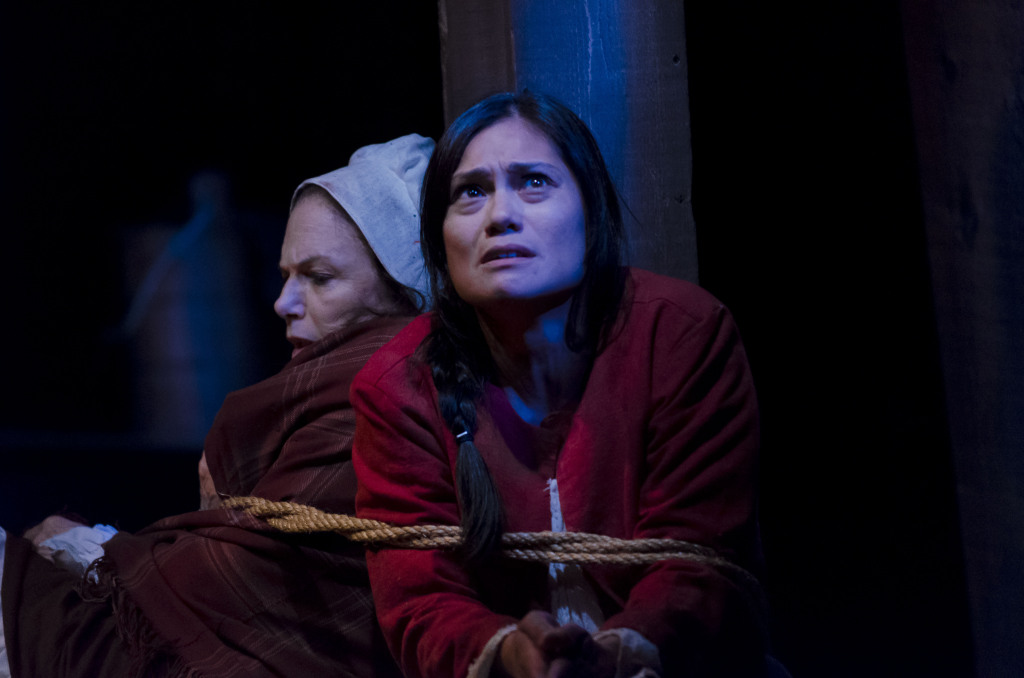
Photograph credit: Kalman Zabarsky
Presented by Boston Playwrights’ Theatre
By Deirdre Girard
Directed by Bridget Kathleen O’Leary
Sept. 25 – Oct. 19, 2014
Boston Playwrights’ Theater
Boston, MA
BPT on Facebook
Review by Kitty Drexel
(Boston, MA) It feels like I’m the only person who’s never heard of Hannah Duston. My friends had plenty to say when I mentioned seeing this show. In 1697, she was captured by Canadian Abenaki Native Americans and transported to what is now Pennacook, NH. After freeing herself with the aid of two other captives, Hannah killed 11 natives and sought safety away from the Abenaki. In a surprising twist to the story, Hannah has all but left the camp where she was held hostage but then returns to scalp the Abenaki for a bounty. At the time, she was lauded for her success and the first statue to commemorate a woman in the US ever was placed in Boscawen, NH. The second statue is currently located in Haverhill, MA (There’s confusion as to which is which.). Duston is considered a folk hero by some (typically White). She is considered a violent, racist Puritan by many others.
In Reconsidering Hanna(h), Hannah Duston’s violent scalping legacy is set alongside the recovery of current day feminist journalist Hanna (both played by Celeste Oliva). Hanna is grieving for the loss of her husband and hasn’t left the house in daytime clothing or taken a new assignment in months. With the help of her friends, Matt (Barlow Adamson) and Joanna (Caroline Lawton), Hanna gets back on her feet. With the help of her nurse Mary (Kippy Goldfarb), Duston is freed from the Abenaki. In both worlds, the women find reasons to get out of bed again, to spare victims from blame, and to forgive in order to survive tragedy.
Girard juxtaposes scenes of Hanna’s depression and recovery with scenes from Duston’s capture and escape. Own heroines similar but vastly different stages of recovery are revealed by Girard to the audience through emotionally charged discourse in layers like an onion. The closer we get to the heart of their plight, we more susceptible we are to vulnerability.
Girard does an excellent job of navigating a thin line between racism/appropriation and what can be viewed as universal themes of a victim’s survival with her script. Director, O’Leary lead her cast exceptionally well. The pace of the show is steady and the cast weaves through their scenes with a natural rhythm. Their acting brings out the subtle (and sometimes not so) threads of feminism and brutality within both plot lines. Oliva as the Hanna(h)s embraces both timelines with arms wide open. She might as well be both characters considering how committed she was to her delivery. Oliva makes clear choices and gives both of her roles equal believability and true life on the stage.
The scenic (Anthony Phelps), lighting (Karen Perlow), and sound design (Mark Bruckner) beautifully transition the audience from the woods of 1967’s New Hampshire to a modern log cabin. The set blends the modern with the colonial as the lighting and sound take the audience through time. The musical interludes distracted the audience long enough for the actors to segue into the next scene. They did a fantastic job making the BPT unrecognizable.
A note: This production opens a dialogue on racist and feminist topics such as scalping, rape, the drug war (on POCs), victim blaming, and appropriation. If you don’t believe in intersectional equality for all and feel threatened by breach of privilege, this show is not for you.
Note continued: Celeste Oliva is exceptional as Hanna(h). Her casting might come as a surprise to some. Oliva is a Person of Color and an excellent actress. If one looks at an historical account of casting in theatre, one would assume that these two qualities were mutually exclusive. It was an awesome experience to sit in an audience as a discussion about race and feminism was discussed by a person representing both factions with* White people. Something as universal as tragedy and recovery doesn’t have to be portrayed by a White person in order to be universal**.
*Versus separately, as is the usual representation in the media.
**Duh, if it’s universal anyone can do it. If a Person of Color can’t play a “universal” role then the role isn’t universal.
